Oklahoma is a state that is best known for its stunning mountain ranges and vast prairies. It is an incredibly diverse state which is home to many fascinating animals – both large and small. Snakes are particularly abundant, and there are 47 species in the state. Seven of these snakes are venomous – including the well-known cottonmouth. But where do they live in the state, and how dangerous are they? Read on to learn all about cottonmouths in Oklahoma!
Cottonmouths: Background
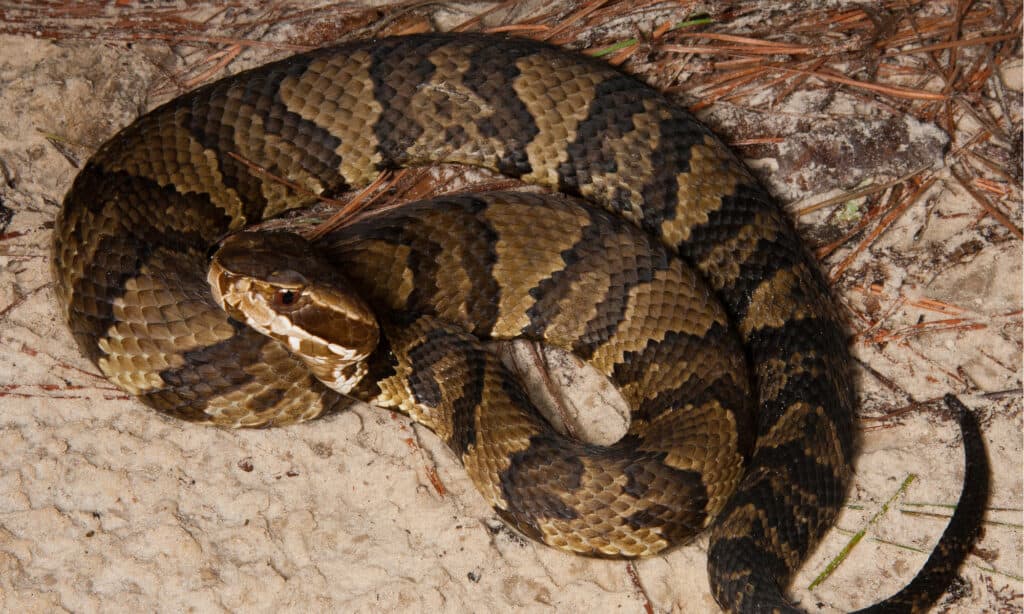
Cottonmouths are venomous snakes.
©Nathan A Shepard/Shutterstock.com
There are currently two species of cottonmouth snakes – northern cottonmouths and Florida cottonmouths – which occur in the southeastern region of the United States. However, there originally only used to be only one species, but with three subspecies – Florida, western, and eastern. After much research, it was found that there were no genetic or distinguishable differences between the eastern and western subspecies. However, the Florida subspecies is different. Therefore, Florida cottonmouths (Agkistrodon conati) were reclassified as a species in their own right, while the eastern and western subspecies were amalgamated into one species, which is now known as the northern cottonmouth (Agkistrondon piscivorus).
Florida cottonmouths are found only in Florida and parts of Georgia, while the northern cottonmouth is found across the rest of their range. The northern cottonmouth is the species that live in Oklahoma, but for the remainder of this article, we’ll simply refer to them as cottonmouths.
What do Cottonmouths in Oklahoma Look Like and How Do They Behave?
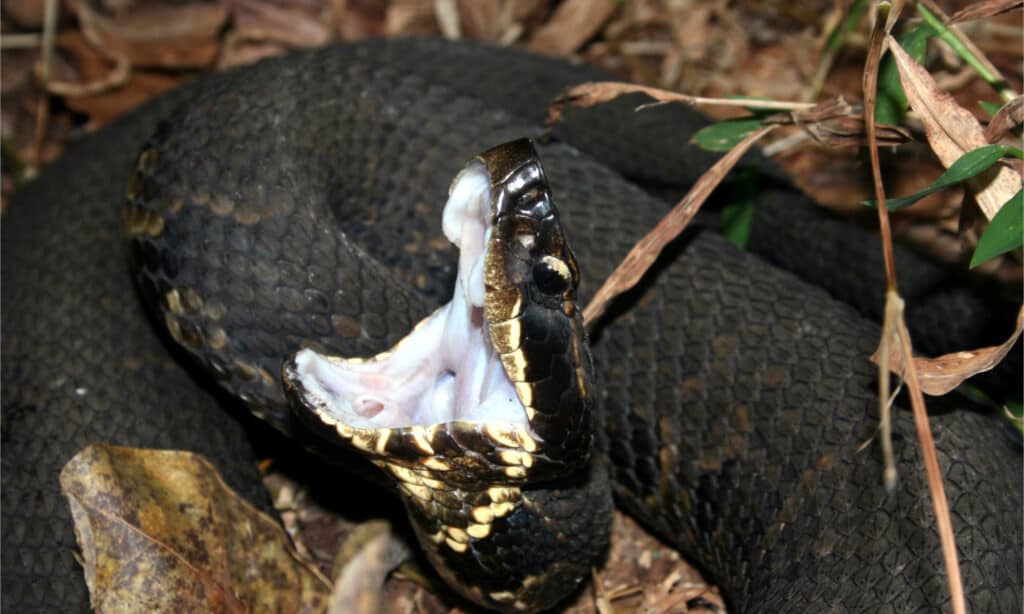
All cottonmouths have a white color in their mouth.
©Psychotic Nature/Shutterstock.com
Cottonmouths are semi-aquatic pit vipers and can reach lengths between 30 and 48 inches with large, heavy bodies that are dark colored. Most cottonmouths are dark brown with darker or black crossbands. However, in some cases, the ground color can be black – or almost so – which renders the crossbands indistinguishable. Cottonmouths also have flat heads and heat-sensing pits between their nostrils and eyes, which allow them to detect their prey by the heat from their bodies.
Juvenile cottonmouths don’t look the same as adults, though. They have a light brown or tan ground color with reddish crossbands and a highly distinguishable yellow tail tip.
However, the most distinguishable feature of any cottonmouth is the feature that gives its name – the mouth. This is because all cottonmouths – young and old – have a white color inside their mouth that looks like cotton. Although this really isn’t the most advisable way to identify a cottonmouth, they do tend to show off this white lining while making a defensive display. This defensive display is what cottonmouths do when they are threatened, and it involves them coiling their bodies round while opening their mouth in an attempt to ward off the threat.
Where are the Cottonmouths in Oklahoma?
Cottonmouths are also known as water mocassins because of their prowess in the water. They are always near a permanent water source – such as rivers, lakes, streams, swamps, and ditches. However, cottonmouths are not found across all of Oklahoma. Instead, they mainly occur in the southeastern corner in the counties of Atoka, Bryan, Choctaw, Haskell, Latimer, LeFlore, McCurtain, Pittsburg, and Pushmataha. Cottonmouths are rarely found outside of these counties.
Cottonmouths are active between the months of April and October. They are primarily nocturnal, which lessens the chance of you seeing one. However, on warm afternoons, they can be seen basking near the water’s edge.
Cottonmouth Venom
Venomous snakes usually contain either proteolytic, hemotoxic, cytotoxic, or neurotoxic venom, which attacks the body differently. Cottonmouths have cytotoxic venom, which works by destroying tissue. Even though not many people die as a result, cottonmouth venom can still cause serious tissue damage and scarring. Sometimes, the damage is so bad that amputation is needed.
Cottonmouths have a high venom yield, and each bite produces approximately 125mg of venom. The highest amounts are approximately 237mg. A bite containing 100 to 150mg of venom can kill a human.
How Deadly are Cottonmouths in Oklahoma?
Snakes have long been an animal that many people are frightened of, and not without good reason. Statistically, venomous snakes bite 7,000 to 8,000 people in the US every year which results in an average of five deaths.
However, cottonmouths are responsible for only around 1% of these. Despite this, if we only look at bites that happened in the known range of cottonmouths, then it becomes 7.3% – a much higher figure.
There are no records indicating any deaths from cottonmouth bites in Oklahoma. However, there was a news story that tells of a six-year-old girl who was bitten by a cottonmouth while wading in a creek in Oklahoma. She survived the bite but required 18 injections of anti-venom to save her; such was the seriousness of the bite.
What to Do if You See a Cottonmouth
Most venomous snakes bite when they are accidentally trodden on. However, as cottonmouths spend a lot of time in the water, bites from these snakes can happen there too.
Approximately 50% of cottonmouths attempt to escape when they are threatened or disturbed. However, approximately 78% will then try to defend themselves if they cannot immediately escape – either by using their defensive position to scare the threat away or by actively striking at the threat.
Therefore, you should not ever approach a cottonmouth or attempt to handle it or move it out of your way. The best way to avoid being bitten by these snakes is to steer clear of them and move away instantly if you do accidentally find yourself too close to one. As they spend a lot of the time in the water, cottonmouths see this as their place of safety and the water is therefore where they are likely to head to escape.
If you are unlucky enough to be bitten by a cottonmouth then the symptoms include swelling of the area and intense pain. You must seek medical help immediately. Even if the bite doesn’t seem to be that bad then you should still get it checked out by a medical professional as these bites can quickly worsen even in a few hours. Most cottonmouth bites are able to be successfully treated with antivenom, but this needs to be administered straight away for the best results.
Other Water Snakes in Oklahoma
There are several harmless water snakes that are often misidentified as cottonmouths. Unfortunately, some people kill these snakes as they think they are cottonmouths. Therefore, you should know how to identify these snakes too.
Northern Water Snake
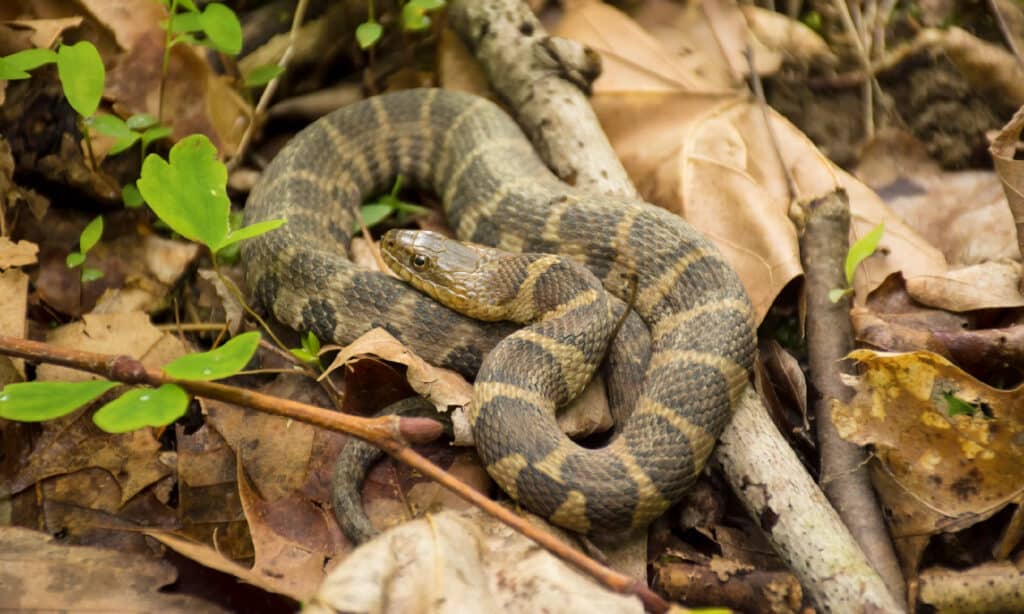
Northern water snakes are not venomous.
©iStock.com/IcemanJ
The northern water snake is the snake that is most often mistaken for a cottonmouth. They can reach 54 inches long and are dark brown to black with darker blotches and crossbands across their body. There are two subspecies of the northern water snake which are found statewide in rivers, lakes, and swamps. However, they are not venomous and prey mainly on fish and frogs.
Banded Water Snake
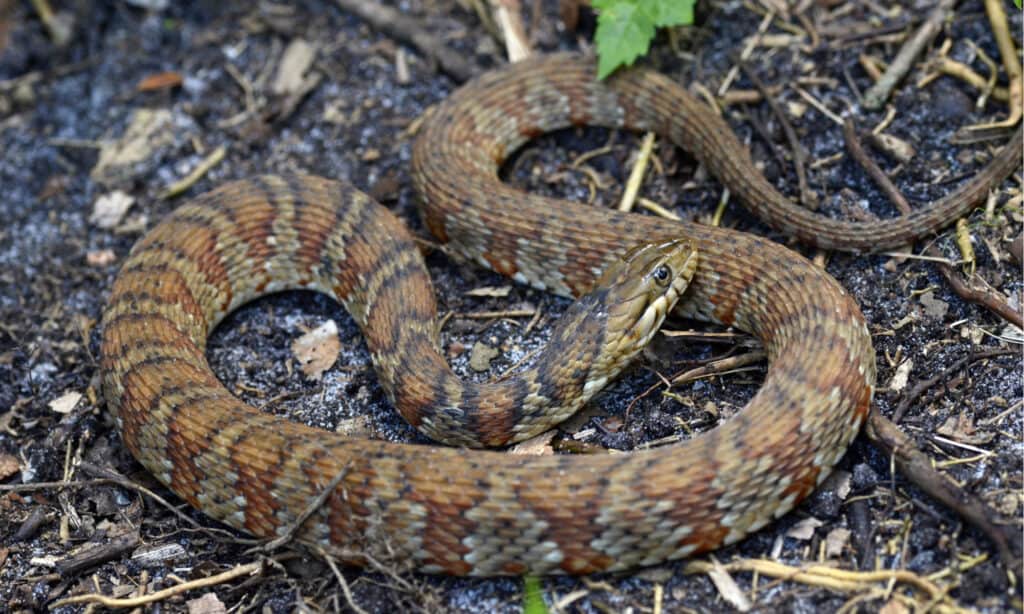
You can find banded water snakes in the same area as cottonmouths in Oklahoma.
©Patrick K. Campbell/Shutterstock.com
The banded water snake is approximately 42 inches long and has a brown-colored body and darker brown crossband markings. They also have a dark stripe extending between their eye and the corner of their mouth. Banded water snakes live in rivers, lakes, and swamps across the same area of Oklahoma as cottonmouths.
Diamond-Backed Water Snake
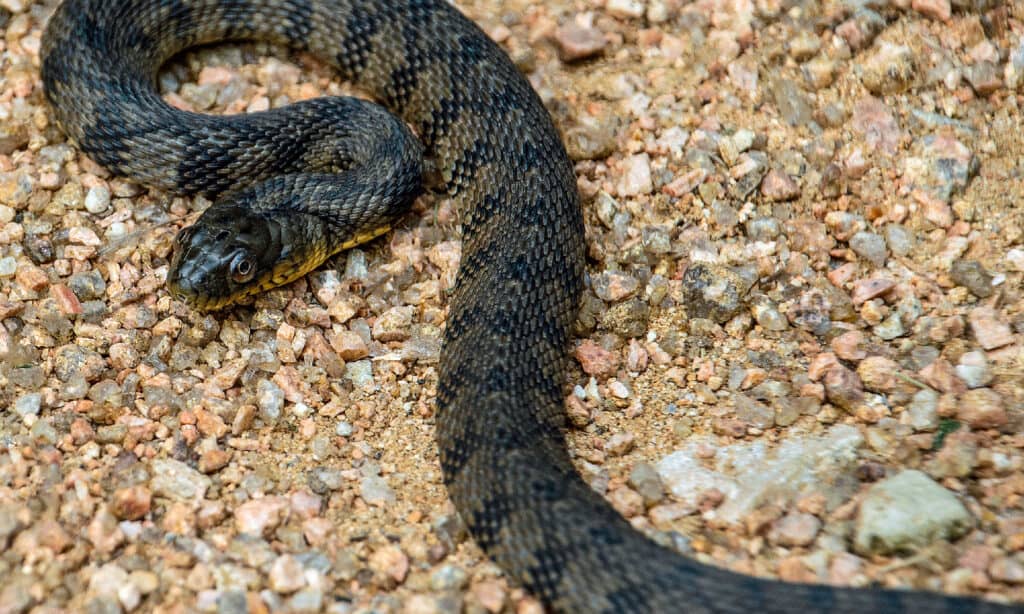
Diamond-backed water snakes are non-venomous.
©iStock.com/williamhc
The diamond-backed water snake is 30 to 48 inches long and has a dark brown body with black blotches. However, these blotches are connected with diagonal black lines. They are common across most of Oklahoma but prefer to live in areas with plenty of vegetation. Although they are not venomous, they react aggressively if handled and release a foul-smelling musk.
Up Next
- Discover the 5 Types of Rattlesnakes in Oklahoma
- When Do Snakes Come Out in Oklahoma?
- Discover Oklahoma’s 6 Largest and Most Dangerous Snakes
The photo featured at the top of this post is © Ad Konings/Shutterstock.com
Discover the "Monster" Snake 5X Bigger than an Anaconda
Every day A-Z Animals sends out some of the most incredible facts in the world from our free newsletter. Want to discover the 10 most beautiful snakes in the world, a "snake island" where you're never more than 3 feet from danger, or a "monster" snake 5X larger than an anaconda? Then sign up right now and you'll start receiving our daily newsletter absolutely free.
Sources
- The Oklahoman, Available here: https://eu.oklahoman.com/story/news/1989/06/18/cottonmouths-habitat-limited-in-oklahoma/62610351007/
- Newsleader, Available here: https://eu.news-leader.com/story/news/local/ozarks/2018/05/24/missouri-girl-survives-cottonmouth-snake-bite/637851002/
- Live Science, Available here: https://www.livescience.com/43597-facts-about-water-moccasin-cottonmouth-snakes.html#:~:text=%22Like%20all%20pit%20vipers%2C%20%5B,which%20is%20often%20potential%20prey.
- Centers for Disease Control and Prevention, Available here: https://www.cdc.gov/niosh/topics/snakes/default.html#:~:text=Each%20year%2C%20an%20estimated%207%2C000,than%20to%20die%20from%20them
- National Library of Medicine, Available here: https://www.ncbi.nlm.nih.gov/books/NBK546645/
Thank you for reading! Have some feedback for us? Contact the AZ Animals editorial team.






